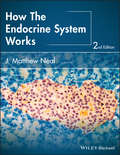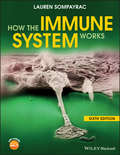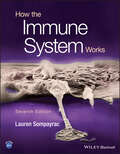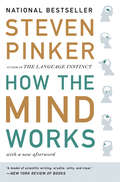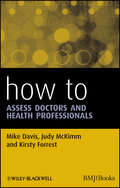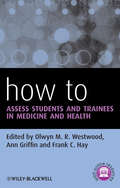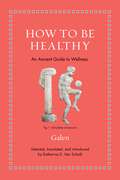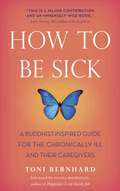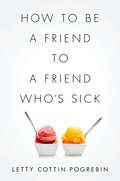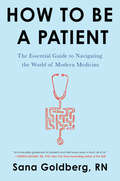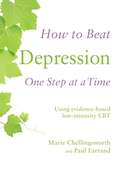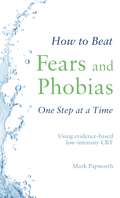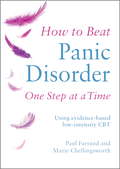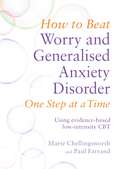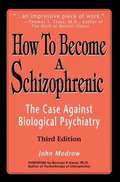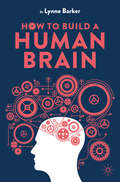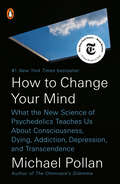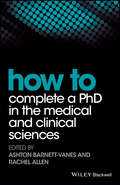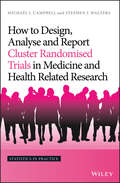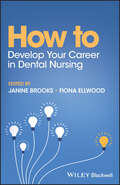- Table View
- List View
How the Cows Turned Mad
by Maxime Schwartz Edward SchneiderThis scientific thriller, available in English for the first time and updated with a new chapter on developments in 2001, tells of the hunt for the cause of an enigmatic class of fatal brain infections, of which mad cow disease is the latest incarnation.
How the Endocrine System Works
by J. Matthew NealHow the Endocrine System Works is not another standard introduction to endocrinology, but an innovative and fun way to learn about the importance of the key glands in the human body and the hormones they control. It is explained in 9 easy-to-understand lectures, with additional material on the treatment and management of endocrine disorders.How the Endocrine System Works:* Is designed for those in need of a concise introduction to this fascinating area of medicine * Has been rigorously updated to reflect today's endocrinology teaching* Includes more focus on the treatment and management of endocrine disorders* Features more on evidence-based medicine, obesity, epidemiology, and biostatistics* Includes summaries of key research which affects diagnostic criteria* Includes brand new case-based review questions at the end of each chapter* Features full-color diagrams throughoutHow the Endocrine System Works is the perfect introduction for all medical students, as well as for students of bioscience, and other healthcare disciplines.
How the Immune System Works (The How it Works Series)
by Lauren M. SompayracHow the Immune System Works has helped thousands of students understand what’s in their hefty immunology tomes and textbooks. In this book, Dr. Sompayrac cuts through the jargon and details to reveal, in simple language, the essence of this complex subject: how the immune system fits together, how it protects us from disease and, perhaps most importantly, why it works the way it does.
How the Immune System Works (The\how It Works Ser.)
by Lauren M. SompayracHow the Immune System Works How the Immune System Works provides a concise and accessible overview of how the immune system protects us from disease. Written in a lively and engaging style, this unique book makes it easy to see the big picture of the immune system—without any confusing jargon or complex technical details. Now in its seventh edition, this popular book features an entirely new chapter that describes the role of the immune system in fighting COVID-19, as well as up-to-date information on vaccines, immunotherapies, immunological memory, cancer, and more. This new edition includes a wide range of effective learning features, such as enhanced artwork, “heads up!” boxes that outline each chapter, and an expanding summary figure at the end of each chapter that illustrates the interaction of different parts of the immune system. How the Immune System Works, Seventh Edition is a must-have for all medical students, bioscience students, veterinary students, nursing students, researchers looking for a quick refresher, and general readers with interest in the subject. Reviews of the previous edition: “The voice of the author is one of a true teacher whose enthusiasm for the subject is contagious. There are far too many dry ‘academic’, or ‘scientific’ textbooks around and this book felt very fresh in comparison.” —Medical Student, University of Texas, South Western Medical Center at Dallas “This is the book that every student (regardless of level) should read as he or she begins to study immunology.” —Daniel G. Tenen, M.D. Professor of Medicine, Harvard Medical School
How the Mind Works
by Steven Pinker"A model of scientific writing: erudite, witty, and clear." --New York Review of Books In this Pulitzer Prize finalist and national bestseller, one of the world's leading cognitive scientists tackles the workings of the human mind. What makes us rational--and why are we so often irrational? How do we see in three dimensions? What makes us happy, afraid, angry, disgusted, or sexually aroused? Why do we fall in love? And how do we grapple with the imponderables of morality, religion, and consciousness? ?How the Mind Works? synthesizes the most satisfying explanations of our mental life from cognitive science, evolutionary biology, and other fields to explain what the mind is, how it evolved, and how it allows us to see, think, feel, laugh, interact, enjoy the arts, and contemplate the mysteries of life. This new edition of Pinker's bold and buoyant classic is updated with a new foreword by the author.
How to Assess Doctors and Health Professionals
by Mike Davis Judy Mckimm Kirsty ForrestThis important book offers an introduction to the theory and the varying types of assessment for health care professionals. The book includes information on such topics as Where have work based assessments come from?; Why do we have different parts to the same exam like MCQs and OSCEs?; How do colleges decide who has passed or not?; Why can people pick their own assessors for their MSF?; The role of formative assessment Portfolios and their value. The book avoids jargon, is clear and succinct, and gives the pros and cons of the different assessment processes.
How to Assess Students and Trainees in Medicine and Health
by Frank C. Hay Olwyn M. Westwood Ann GriffinDo you want to improve standards of practice?Do you know how to construct examinations so that they are fit for purpose?Can you give constructive feedback to aid development?How to Assess Students and Trainees in Medicine and Health will help you develop these vital skills and much more.This brand new title is an ideal resource for those keen to promote best practice in assessment, evaluation and feedback. From the theoretical basics of medical education to the various types of assessment used today, the book considers the practical issues surrounding assessment, with 'trouble shooting' help for those designing and writing assessments.With hints and tips drawn from experienced medical educators, How to Assess Students and Trainees in Medicine and Health is fully supported by a companion website at www.wiley.com/go/assesshealth containing worked examples and sample exemplar assessments that can be modified for personal use, making this the ultimate guide to mastering assessment, evaluation and development of students and trainees.
How to Be Healthy: An Ancient Guide to Wellness (Ancient Wisdom for Modern Readers)
by GalenTimeless wisdom about how to be healthy in body and mind from one of the greatest physicians of the ancient worldThe second-century Greek physician Galen—the most famous doctor in antiquity after Hippocrates—is a central figure in Western medicine. A talented doctor, surgeon, writer, philosopher, teacher, pharmacologist, and inventor, Galen attended the court of Marcus Aurelius, living through outbreaks of plague (likely smallpox) that devastated the Roman Empire. He also served as physician for professional gladiators, boasting that only two fighters died during his first year (his predecessor had lost sixteen). In writings that provided the foundation of Western medicine up to the nineteenth century, Galen created a unified account of health and disease. In How to Be Healthy, practicing physician and classical historian Katherine Van Schaik presents a collection of Galen’s enduring insights about how we can take care of our bodies and minds, prevent disease, and reach a healthy old age.Although we now know that many of Galen’s ideas about physiology are wrong, How to Be Healthy shows that much of his advice remains sound. In these selections from his writings, presented in fresh translations, Galen discusses the art of medicine, exercise and diet, the mind-body connection, the difficulty of applying general medical principles to individuals, and much more. Featuring an introduction, brief commentaries that connect ancient medical practices to modern ones, and the original Greek on facing pages, How to Be Healthy offers an entertaining and enlightening new perspective on the age-old pursuit of wellness, from the importance of “the exercise with a small ball” to the benefits of “avoiding distress.”
How to Be Loved: A Memoir of Lifesaving Friendship
by Eva HagbergA luminous memoir about how friendship saved one woman&’s life, for anyone who has loved a friend who was sick, grieving, or lost—and for anyone who has struggled to seek or accept help Eva Hagberg spent her lonely youth looking everywhere for connection: drugs, alcohol, therapists, boyfriends, girlfriends. Sometimes she found it, but always temporarily. Then, at age thirty, an undiscovered mass in her brain ruptured. So did her life. A brain surgery marked only the beginning of a long journey, and when her illness hit a critical stage, it forced her to finally admit the long-suppressed truth: she was vulnerable, she needed help, and she longed to grow. She needed true friendship for the first time. How to Be Loved is the story of how an isolated person&’s life was ripped apart only to be gently stitched back together through friendship, and the recovery—of many stripes—that came along the way. It explores the isolation so many of us feel despite living in an age of constant connectivity; how our ambitions sometimes pull us apart more than bring us together; and how a simple doughnut, delivered by a caring soul, can become the essence of what makes a life valuable. With gorgeous prose shot through with empathy, pain, fear, and the secret truths inside all of us, Eva writes about the friends who taught her to grow up and open her heart—and how the relentlessness of suffering can give rise to the greatest joy.
How to Be Sick
by Sylvia Boorstein Toni BernhardThis life-affirming, instructive, and thoroughly inspiring book is a must-read for anyone who is - or who might one day be - sick. It can also be the perfect gift of guidance, encouragement, and uplifting inspiration to family, friends, and loved ones struggling with the many terrifying or disheartening life changes that come so close on the heels of a diagnosis of a chronic condition or life-threatening illness. Authentic and graceful, How to be Sick reminds us of our endless inner freedom, even under high degrees of suffering and pain. The author - who became ill while a university law professor in the prime of her career - tells the reader how she got sick and, to her and her partner's bewilderment, stayed that way. Toni had been a longtime meditator, going on long meditation retreats and spending many hours rigorously practicing, but soon discovered that she simply could no longer engage in those difficult and taxing forms. She had to learn ways to make "being sick" the heart of her spiritual practice - and through truly learning how to be sick, she learned how, even with many physical and energetic limitations, to live a life of equanimity, compassion, and joy. And whether we ourselves are ill or not, we can learn these vital arts from Bernhard's generous wisdom in How to Be Sick.
How to Be a Friend to a Friend Who's Sick
by Letty Cottin PogrebinEveryone knows someone whoOCOs sick or suffering. Yet when a friend or relative is under duress many of us feel uncertain about how to cope. Throughout her recent bout with breast cancer, Letty Cottin Pogrebin became fascinated by her friendsOCO and familyOCOs diverse reactions to her and her illness: how awkwardly some of them behaved; how some misspoke or misinterpreted her needs; and how wonderful it was when people read her right. She began talking to her fellow patients and dozens of other veterans of serious illness, seeking to discover what sick people wished their friends knew about how best to comfort, help, and even simply talk to them. Now Pogrebin has distilled their collective stories and opinions into this wide-ranging compendium of pragmatic guidance and usable wisdom. Her advice is always infused with sensitivity, warmth, and humor. It is embedded in candid stories from her own and othersOCO journeys, and their sometimes imperfect interactions with well-meaning friends. "How to Be a Friend to a Friend WhoOCOs Sick" is an invaluable guidebook for anyone hoping to rise to the challenges of this most important and demanding passage of friendship.
How to Be a Patient: The Essential Guide to Navigating the World of Modern Medicine
by Sana GoldbergFrom registered nurse and public health advocate Sana Goldberg, RN, a timely, accessible, and comprehensive handbook to navigating common medical situations. From the routine to the unexpected, How to Be a Patient is your ultimate guide to better healthcare.Did you know that patients have statistically better outcomes when their surgeon is female? That you can mark-up an informed consent sheet before you sign it, or get second opinions on CTs and MRIs? That there’s a blue book for healthcare procedures, or an algorithm to decide between ER, Urgent Care, and waiting-until-Monday?In How to Be a Patient, nurse and public health advocate Sana Goldberg walks readers through the complicated and uncertain medical landscape, illuminating a path to better care.Warm and disarmingly honest, Goldberg’s advice is as expert as it is accessible. In the face of an epidemic of brusque, impersonal care she empowers readers with the information and tools to come to good decisions with their providers and sidestep the challenging realities of modern medicine.With sections like When All is Well, When It’s An Emergency, When It’s Your Person, and When You Have to Stand Up to the Industry, along with appendices to help track family history, avoid pointless medical tests, and choose when and where to undergo a procedure, How to Be a Patient is an invaluable and essential guide for a new generation of patients.
How to Be a Researcher: A strategic guide for academic success
by Jonathan St EvansHow to be a Researcher provides a strategic guide to the conduct of a successful research career within a university environment. Based on the author’s extensive personal experience, it offers down-to-earth advice, philosophical guidance, and discussions of the political context of academic research. This is not a research methods book, and the topics it covers are rarely discussed elsewhere. The bulk of the book provides practical advice on the development of essential skills and strategic approaches, covering questions such as: how to decide which topics to work on how to read and review literature how to develop theory how to integrate research and teaching activity how to approach research design how to obtain and manage research funding how to collaborate and supervise effectively how to write up your research, and how to secure the best sources of publication. The final part of the book considers the philosophy and psychology of research work and includes an exploration of the cognitive biases which may affect researchers. How to be a Researcher will be particularly useful for masters and doctoral students in the behavioral and social sciences, and also for early career academics developing research within a university career.
How to Beat Depression One Step at a Time: Using evidence-based low-intensity CBT (How To Beat #2)
by Paul Farrand Marie ChellingsworthThe IAPT programme, initiated in 2008, offers both high-intensity and low-intensity therapy. There are currently no self-help materials catering for low-intensity patients. This is the first in a new series of short self-help books for low intensity patients, covering topics such as OCD; generalised anxiety; and panic and agoraphobia. The government continues to invest in IAPT, with the focus shifting towards having more low-intensity workers. Based upon an evidence based cognitive behavioural therapy approach, this book is written in a friendly, engaging (and jargon-free!) style and encourages interactive reading through tables, illustrations and worksheets. Real life case studies illustrate the use of each intervention and demonstrate how a patient can work through an issue.
How to Beat Fears and Phobias One Step at a Time: Using evidence-based low-intensity CBT
by Mark PapworthImproving Access to Psychological Therapies (IAPT), initiated in 2008, has made psychological therapy more accessible to those in need. This series of self-help titles is the first to be created specifically for low-intensity IAPT, and all titles follow an evidence-based cognitive behavioural therapy (CBT) approach which is the treatment of choice for depression and anxiety disorders. They are written by authors with considerable experience in the field of CBT self-help research, training and clinical practice.This book is the perfect resource for helping you beat fears and phobias, either by yourself or in conjunction with the support of an IAPT service. It is written in a friendly, engaging (and jargon-free!) style and encourages interactive reading through tables, illustrations and worksheets. Real-life case studies illustrate the use of the therapy and demonstrate how you can gradually overcome your fear of the thing that frightens you. This book will help you to understand your phobia and face your fears through graded exposure therapy.
How to Beat Fears and Phobias One Step at a Time: Using evidence-based low-intensity CBT (How To Beat #10)
by Mark PapworthImproving Access to Psychological Therapies (IAPT), initiated in 2008, has made psychological therapy more accessible to those in need. This series of self-help titles is the first to be created specifically for low-intensity IAPT, and all titles follow an evidence-based cognitive behavioural therapy (CBT) approach which is the treatment of choice for depression and anxiety disorders. They are written by authors with considerable experience in the field of CBT self-help research, training and clinical practice.This book is the perfect resource for helping you beat fears and phobias, either by yourself or in conjunction with the support of an IAPT service. It is written in a friendly, engaging (and jargon-free!) style and encourages interactive reading through tables, illustrations and worksheets. Real-life case studies illustrate the use of the therapy and demonstrate how you can gradually overcome your fear of the thing that frightens you. This book will help you to understand your phobia and face your fears through graded exposure therapy.
How to Beat Panic Disorder One Step at a Time: Using evidence-based low-intensity CBT (How To Beat #3)
by Paul Farrand Marie ChellingsworthHow to Beat Panic Disorder One Step at a Time is specifically addressed to low-intensity patients and follows an evidence-based cognitive behavioural therapy (CBT) approach.This book is the perfect resource for helping you to beat panic attacks and panic disorder, either by yourself or in conjunction with the support of an IAPT service. Written in a friendly, engaging (and jargon-free!) style, the book encourages interactive reading through tables, illustrations and worksheets. Real-life case studies illustrate the use of each intervention and demonstrate how you can work through your condition. This book will help you to understand your panic cycle, and to face your fears through gradual exposure.Paul Farrand and Marie Chellingsworth have both worked at a national level in the area of CBT self-help research and training, with past involvement in organisations and programmes as diverse as the Department of Health, British Psychological Society, Psychological Wellbeing Practitioners and the British Association for Behavioural and Cognitive Psychotherapies.
How to Beat Worry and Generalised Anxiety Disorder One Step at a Time: Using evidence-based low-intensity CBT (How To Beat #5)
by Paul Farrand Marie ChellingsworthHow to Beat Worry and Generalised Anxiety Disorder One Step at a Time is specifically addressed to low-intensity patients and follows an evidence-based cognitive behavioural therapy (CBT) approach. This book is the perfect resource for helping you to beat worry or Generalised Anxiety Disorder, either by yourself or in conjunction with the support of an IAPT service. The book is written in a friendly, engaging (and jargon-free!) style and encourages interactive reading through tables, illustrations and worksheets. Real-life case studies illustrate the use of each intervention and demonstrate how you can work through your anxiety. The book teaches you effective CBT techniques for managing your worry more effectively and releasing tension through Progressive Muscle Relaxation.
How to Beat Your Fears and Worries (How To Beat #1)
by Helen KennerleyOvercoming app now available.We all worry about stuff in our lives, but some of us may find ourselves worrying excessively, even about those things completely beyond our control. Or we may simply find that worrying thoughts are dominating our daily life and are destroying our quality of life. Of course we all have worries, but rather than labelling yourself a 'worry wart' or 'worrier', you can overcome your chronic anxiety and start to lead a happier, more fulfilling life. Cognitive Behavioural Therapy, on which this self-help book is based, is a recognised, effective treatment for anxiety. It will help you to recognise and challenge your negative and anxious thoughts, and change any behaviour which may have inadvertently kept your anxiety going, and move towards a more worry-free future.
How to Become a Schizophrenic: The Case Against Biological Psychiatry
by John ModrowThe author describes his experience as a diagnosed schizophrenic and then examines the medical model of schizophrenia, which he believes to be seriously flawed.
How to Build a Human Brain
by Lynne BarkerHow to Build a Human Brain takes a developmental approach to understanding brain structure and function. It guides readers through the evolution of the human brain, from its cellular building blocks, up to hind brain structures and functions, and through to neocortex and associated functions. In doing so, it enables students to develop a comprehensive knowledge of the relationship between brain networks and functions, neural underpinnings of functional problems seen after neuropathology, and neuroanatomy.Written in an engaging style, each chapter follows a blueprint format with subsections on issues like 'damage and repair' and 'faulty wiring' as the brain is ‘built’ across the course of the book. The author includes illustrative case studies and entertaining fast fact boxes to highlight the real-word relevance of each brain structure being examined. This textbook offers an accessible reference for students of neuroscience, cognitive neuroscience, neuropsychology,and biological psychology.
How to Change Your Mind: What the New Science of Psychedelics Teaches Us About Consciousness, Dying, Addiction, Depression, and Transcendence
by Michael PollanNew York Times Book Review 10 Best Books of 2018A New York Times Notable Book The #1 New York Times bestseller.A brilliant and brave investigation into the medical and scientific revolution taking place around psychedelic drugs--and the spellbinding story of his own life-changing psychedelic experiences When Michael Pollan set out to research how LSD and psilocybin (the active ingredient in magic mushrooms) are being used to provide relief to people suffering from difficult-to-treat conditions such as depression, addiction and anxiety, he did not intend to write what is undoubtedly his most personal book. But upon discovering how these remarkable substances are improving the lives not only of the mentally ill but also of healthy people coming to grips with the challenges of everyday life, he decided to explore the landscape of the mind in the first person as well as the third. Thus began a singular adventure into various altered states of consciousness, along with a dive deep into both the latest brain science and the thriving underground community of psychedelic therapists. Pollan sifts the historical record to separate the truth about these mysterious drugs from the myths that have surrounded them since the 1960s, when a handful of psychedelic evangelists inadvertently catalyzed a powerful backlash against what was then a promising field of research.A unique and elegant blend of science, memoir, travel writing, history, and medicine, How to Change Your Mind is a triumph of participatory journalism. By turns dazzling and edifying, it is the gripping account of a journey to an exciting and unexpected new frontier in our understanding of the mind, the self, and our place in the world. The true subject of Pollan's "mental travelogue" is not just psychedelic drugs but also the eternal puzzle of human consciousness and how, in a world that offers us both suffering and joy, we can do our best to be fully present and find meaning in our lives.
How to Complete a PhD in the Medical and Clinical Sciences
by Ashton Barnett-Vanes Rachel AllenHow to Complete a PhD in the Medical and Clinical Sciences provides fresh insight into the PhD process and a concise framework to aid current and prospective students undertaking research in the medical and clinical sciences. Filled with useful hints, tips, and practical guidance, the book covers key topics relevant to a PhD researcher such as publishing and presenting, core principles and techniques in medical science, dealing with common pitfalls, and how to write up and move on. Featuring contributions from authors with experience across the PhD research career spectrum, How to Complete a PhD in the Medical and Clinical Sciences is an invaluable resource for those undertaking their doctoral studies.
How to Design, Analyse and Report Cluster Randomised Trials in Medicine and Health Related Research
by Michael J. Campbell Stephen J. WaltersA complete guide to understanding cluster randomised trials Written by two researchers with extensive experience in the field, this book presents a complete guide to the design, analysis and reporting of cluster randomised trials. It spans a wide range of applications: trials in developing countries, trials in primary care, trials in the health services. A key feature is the use of R code and code from other popular packages to plan and analyse cluster trials, using data from actual trials. The book contains clear technical descriptions of the models used, and considers in detail the ethics involved in such trials and the problems in planning them. For readers and students who do not intend to run a trial but wish to be a critical reader of the literature, there are sections on the CONSORT statement, and exercises in reading published trials.Written in a clear, accessible styleFeatures real examples taken from the authors' extensive practitioner experience of designing and analysing clinical trialsDemonstrates the use of R, Stata and SPSS for statistical analysisIncludes computer code so the reader can replicate all the analysesDiscusses neglected areas such as ethics and practical issues in running cluster randomised trialsHow to Design, Analyse and Report Cluster Randomised Trials in Medicine and Health Related Research provides an excellent reference tool and can be read with profit by statisticians, health services researchers, systematic reviewers and critical readers of cluster randomised trials.
How to Develop Your Career in Dental Nursing (How To (Dentistry))
by Janine Brooks Fiona EllwoodDocuments the challenges, benefits, and progression opportunities of a career in dental nursing How to Develop Your Career in Dental Nursing provides practical information on how to progress your career in dental nursing. Guidance is included throughout, and the reader should use the book to make informed decisions and conduct further research for the benefit of their own career. The book considers the historical context, along with reviewing the current position of dental nursing and considering the future of the field, all with the overarching theme of helping dental nurses further their career in modern dentistry. Topics covered include: Dental Nursing from a profession and social context, as well as gender perspectives Differences in dental nursing worldwide Formal and informal training and education Pros and cons for dental nurses and dentistry as the profession has developed The impact of working in a modern environment How dental nurses can become agents for change Dental nursing as an academic versus vocational endeavorWritten by highly qualified authors, How to Develop Your Career in Dental Nursing is an invaluable resource for Dental Nurses, as well as students beginning their professional journey

